[ 本节目标 ]
1. stack 的介绍和使用
2. queue 的介绍和使用
3. priority_queue 的介绍和使用
4. 容器适配器
5. 本章总结
1. stack 的介绍和使用
1.1 stack 的介绍
stack 的文档介绍
翻译:
1. stack 是一种容器适配器,专门用在具有后进先出操作的上下文环境中,其删除只能从容器的一端进行元素的插入与提取操作。
2. stack 是作为容器适配器被实现的,容器适配器即是对特定类封装作为其底层的容器,并提供一组特定的成员函数来访问其元素,将特定类作为其底层的,元素特定容器的尾部(即栈顶)被压入和弹出。
3. stack 的底层容器可以是任何标准的容器类模板或者一些其他特定的容器类,这些容器类应该支持以下操作:
empty:判空操作
back:获取尾部元素操作
push_back:尾部插入元素操作
pop_back:尾部删除元素操作
4. 标准容器 vector、deque、list 均符合这些需求,默认情况下,如果没有为 stack 指定特定的底层容器,默认情况下使用 deque。
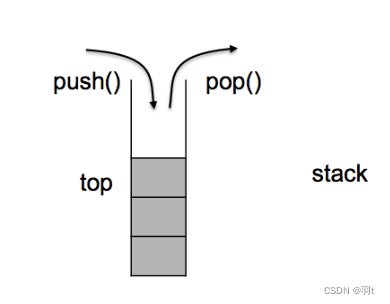
1.2 stack 的使用
| 函数声明 | 接口说明 |
| stack() | 构造空的栈 |
| empty() | 检测stack是否为空 |
| size() | 返回stack中元素的个数 |
| top() | 返回栈顶元素的引用 |
| push() | 将元素val压入stack中 |
| pop() | 将stack中尾部的元素弹出 |
1.3 stack 的模拟实现
从栈的接口中可以看出,栈实际是一种特殊的 vector,因此使用 vector 完全可以模拟实现 stack。
#pragma once
#include<vector>
namespace yut
{
template<class T,class Container>
class stack
{
public:
stack()
{ }
bool empty()
{
return _con.empty();
}
size_t size()
{
return _con.size();
}
T& top()
{
return _con[size() - 1];
}
void push(const T& val)
{
_con.push_back(val);
}
void pop()
{
_con.pop_back();
}
private:
Container _con;
};
}测试代码如下:
#include<iostream>
using namespace std;
#include"stack.h"
int main()
{
yut::stack<int, vector<int>> st;
st.push(1);
st.push(2);
st.push(3);
st.push(4);
while (!st.empty())
{
cout << st.top() << " ";
st.pop();
}
cout << endl;
return 0;
}代码运行结果如下: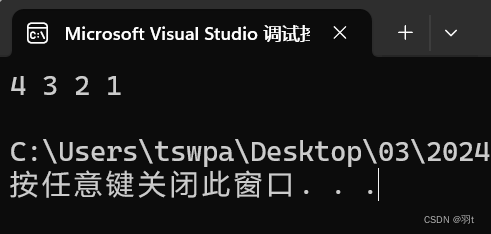
2. queue 的介绍和使用
2.1 queue 的介绍
queue 的文档介绍
翻译:
1. 队列是一种容器适配器,专门用于在 FIFO 上下文(先进先出)中操作,其中从容器一端插入元素,另一端提取元素。
2. 队列作为容器适配器实现,容器适配器即将特定容器类封装作为其底层容器类,queue提供一组特定的成员函数来访问其元素。元素从队尾入队列,从队头出队列。
3. 底层容器可以是标准容器类模板之一,也可以是其他专门设计的容器类。该底层容器应至少支持以下操作:
empty:检测队列是否为空
size:返回队列中有效元素的个数
front:返回队头元素的引用
back:返回队尾元素的引用
push_back:在队列尾部入队列
pop_front:在队列头部出队列
4. 标准容器类 deque 和 list 满足了这些要求。默认情况下,如果没有为 queue 实例化指定容器类,则使用标准容器 deque。

2.2 queue 的使用
| 函数声明 | 接口说明 |
| queue() | 构造空的队列 |
| empty() | 检测队列是否为空,是返回 true,否则返回 false |
| size() | 返回队列中有效元素的个数 |
| front() | 返回队头元素的引用 |
| back() | 返回队尾元素的引用 |
| push() | 在队尾将元素 val 入队列 |
| pop() | 将队头元素出队列 |
2.3 queue 的模拟实现
因为 queue 的接口中存在头删和尾插,因此使用 vector 来封装效率太低,故可以借助 list 来模拟实现 queue,
具体如下:
#pragma once
#include<list>
namespace yut
{
template<class T,class Container>
class queue
{
public:
queue()
{ }
bool empty()
{
return _con.empty();
}
size_t size()
{
return _con.size();
}
T& front()
{
return _con.front();
}
T& back()
{
return _con.back();
}
void push(const T& val)
{
_con.push_back(val);
}
void pop()
{
_con.pop_front();
}
private:
Container _con;
};
}测试代码如下:
#include<iostream>
using namespace std;
#include"queue.h"
int main()
{
yut::queue<int, list<int>> st;
st.push(1);
st.push(2);
st.push(3);
st.push(4);
while (!st.empty())
{
cout << st.front() << " ";
st.pop();
}
cout << endl;
return 0;
}代码运行结果如下: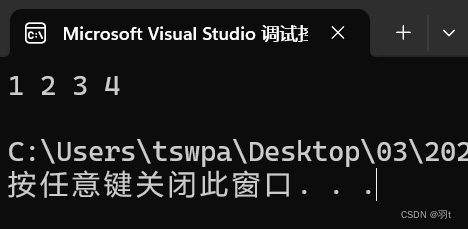
3. priority_queue 的介绍和使用
3.1 priority_queue 的介绍
priority_queue 文档介绍
翻译:
1. 优先队列是一种容器适配器,根据严格的弱排序标准,它的第一个元素总是它所包含的元素中最大的。
2. 此上下文类似于堆,在堆中可以随时插入元素,并且只能检索最大堆元素(优先队列中位于顶部的元素)。
3. 优先队列被实现为容器适配器,容器适配器即将特定容器类封装作为其底层容器类,queue 提供一组特定的成员函数来访问其元素。元素从特定容器的“尾部”弹出,其称为优先队列的顶部。
4. 底层容器可以是任何标准容器类模板,也可以是其他特定设计的容器类。容器应该可以通过随机访问迭代器访问,并支持以下操作:
empty():检测容器是否为空
size():返回容器中有效元素个数
front():返回容器中第一个元素的引用
push_back():在容器尾部插入元素
pop_back(): 删除容器尾部元素
5. 标准容器类 vector 和 deque 满足这些需求。默认情况下,如果没有为特定的 priority_queue 类实例化指定容器类,则使用 vector。
6. 需要支持随机访问迭代器,以便始终在内部保持堆结构。容器适配器通过在需要时自动调用算法函数 make_heap、push_heap 和 pop_heap 来自动完成此操作。
3.2 priority_queue 的使用
优先级队列默认使用 vector 作为其底层存储数据的容器,在 vector 上又使用了堆算法将 vector 中元素构造成堆的结构,因此 priority_queue 就是堆,所有需要用到堆的位置,都可以考虑使用priority_queue。注意:默认情况下 priority_queue 是大堆。
| 函数声明 | 接口说明 |
| priority_queue() / priority_queue(first,last) | 构造一个空的优先级队列 |
| empty( ) | 检测优先级队列是否为空,是返回true,否则返回false |
| top( ) | 返回优先级队列中最大(最小元素),即堆顶元素 |
| push(x) | 在优先级队列中插入元素x |
| pop() | 删除优先级队列中最大(最小)元素,即堆顶元素 |
【注意】:
1. 默认情况下,priority_queue是大堆。
#include<iostream>
using namespace std;
#include<vector>
#include<queue>
#include<functional> // greater算法的头文件
int main()
{
// 默认情况下,创建的是大堆,其底层按照小于号比较
vector<int> v{ 1,2,3,4,5,6,7,8,9 };
priority_queue<int> q1;
for (auto& e : v)
{
q1.push(e);
}
cout << q1.top() << endl;
// 如果要创建小堆,将第三个模板参数换成greater比较方式
// 可能比较奇怪,但它就是这样
priority_queue<int,vector<int>,greater<int>> q2(v.begin(),v.end());
cout << q2.top() << endl;
return 0;
}代码运行结果如下: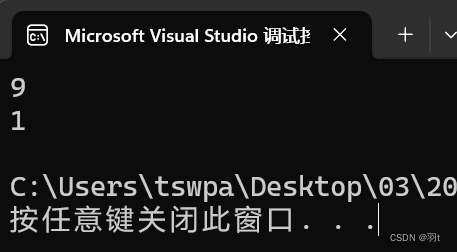
2.如果在 priority_queue 中放自定义类型的数据,用户需要在自定义类型中提供 > 或者 < 的重载
先来一个自定义类型的日期类:
头文件:
#pragma once
#include<iostream>
using namespace std;
class Date
{
friend ostream& operator<<(ostream& _cout, const Date& d);
friend istream& operator>>(istream& _cin, Date& d);
public:
// 获取某年某月的天数
int GetDestiny(int year, int month) const;
// 全缺省的构造函数
Date(int year = 0, int month = 1, int day = 1);
// 拷贝构造函数
//d2(d1)
Date(const Date& d);
// 析构函数
~Date()
{ }
// 赋值运算符重载
// d2=d3 -> d2.operator(&d2,d3)
Date& operator=(const Date& d);
// == 运算符重载
bool operator == (const Date& d) const;
// > 运算符重载
bool operator>(const Date& d)const;
// < 运算符重载
bool operator<(const Date& d)const;
// <= 运算符重载
bool operator<=(const Date& d)const;
// >= 运算符重载
bool operator>=(const Date& d)const;
// != 运算符重载
bool operator!=(const Date& d)const;
// 日期 += 天数
Date& operator+=(int day);
// 日期 -= 天数
Date& operator-=(int day);
// 前置 ++
Date& operator++();
// 后置 ++
Date operator++(int);
// 前置 --
Date& operator--();
// 后置 --
Date operator--(int);
// 日期 + 天数
Date operator+(int day);
// 日期 - 天数
Date operator-(int day);
//日期 - 日期 返回天数
int operator-(const Date& d) const;
//取地址
const Date* operator&() const;
void DatePrintf() const;
private:
int _year;
int _month;
int _day;
};
ostream& operator<<(ostream& _cout, const Date& d)
{
_cout << d._year << "-" << d._month << "-" << d._day << endl;
return _cout;
}
istream& operator>>(istream& _cin, Date& d)
{
_cin >> d._year >> d._month >> d._day;
return _cin;
}.cpp 文件:
#include"Date.h"
int Date::GetDestiny(int year, int month) const
{
static int monthday[13] = { 0,31,28,31,30,31,30,31,31,30,31,30,31 };
if ((year % 4 == 0 && year % 100 != 0) || year % 400 == 0)
{
if (month == 2)
return 29;
}
return monthday[month];
}
Date::Date(int year, int month, int day)
{
if (year >= 0 && month < 13 && month>0 && day <= GetDestiny(year, month))
{
_year = year;
_month = month;
_day = day;
}
else
cout << "非法日期" << endl;
}
Date::Date(const Date& d)
{
_year = d._year;
_month = d._month;
_day = d._day;
}
Date& Date::operator=(const Date& d)
{
_year = d._year;
_month = d._month;
_day = d._day;
return *this;
}
bool Date::operator == (const Date& d)const
{
if (_year != d._year)
return false;
if (_month != d._month)
return false;
if (_day != d._day)
return false;
return true;
}
bool Date::operator>(const Date& d)const
{
if (_year < d._year)
return false;
if (_month < d._month)
return false;
if (_day < d._day)
return false;
return true;
}
bool Date::operator<(const Date& d)const
{
return ((*this) > d ? false : true) && ((*this) == d ? false : true);
}
bool Date::operator<=(const Date& d)const
{
return (*this) > d ? false : true;
}
bool Date::operator>=(const Date& d)const
{
return (*this) < d ? false : true;
}
bool Date::operator!=(const Date& d)const
{
return (*this) == d ? false : true;
}
Date& Date::operator+=(int day)
{
_day += day;
while (_day > GetDestiny(_year, _month))
{
_day -= GetDestiny(_year, _month);
_month++;
if (_month > 12)
{
_year++;
_month = 1;
}
}
return *this;
}
Date& Date::operator-=(int day)
{
_day -= day;
while (_day <= 0)
{
_day += GetDestiny(_year, _month - 1);
_month--;
if (_month == 0)
{
_year--;
_month = 12;
}
}
return *this;
}
Date& Date::operator++()
{
(*this) += 1;
return *this;
}
Date Date::operator++(int)
{
Date tmp = (*this);
(*this) += 1;
return tmp;
}
Date& Date::operator--()
{
(*this) -= 1;
return *this;
}
Date Date::operator--(int)
{
Date tmp = (*this);
(*this) -= 1;
return tmp;
}
Date Date::operator+(int day)
{
Date tmp = (*this);
tmp += day;
return tmp;
}
Date Date::operator-(int day)
{
Date tmp = (*this);
tmp -= day;
return tmp;
}
int Date::operator-(const Date& d) const
{
int flag = 1;
Date max = *this;
Date min = d;
if (max < min)
{
Date tmp = max;
max = min;
min = tmp;
flag = -1;
}
int count = 0;
while (min != max)
{
min++;
count++;
}
return count * flag;
}
const Date* Date::operator&() const
{
return this;
}
void Date::DatePrintf() const
{
cout << _year << "-" << _month << "-" << _day << endl;
}测试代码:
// 我这个日期类是直接拿的以前的,大家简单实现即可。
#include<iostream>
using namespace std;
#include<vector>
#include<queue>
#include<functional>
#include"Date.h"
int main()
{
//大堆,需要用户在自定义类型中提供<的重载
priority_queue<Date> q1;
q1.push(Date(2024, 5, 28));
q1.push(Date(2024, 5, 29));
q1.push(Date(2024, 5, 30));
cout << q1.top() << endl;
// 如果要创建小堆,需要用户提供的重载
priority_queue<Date, vector<Date>, greater<Date>> q2;
q2.push(Date(2024, 5, 28));
q2.push(Date(2024, 5, 29));
q2.push(Date(2024, 5, 30));
cout << q2.top() << endl;
return 0;
}代码运行结果如下: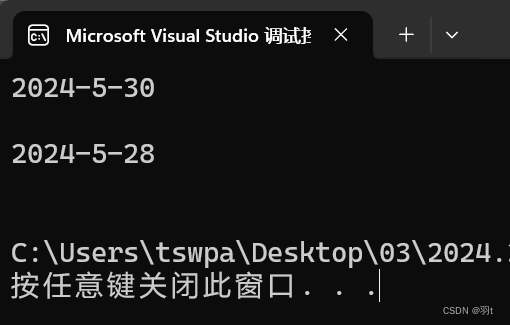
3.3 priority_queue 的模拟实现
由于 priority_queue 的底层结构就是堆,因此此处只需对其进行通用的封装即可。
大堆:
#pragma once
#include<vector>
using namespace std;
namespace yut
{
template<class T, class Container = vector<T>>
class priority_queue
{
public:
priority_queue()
{ }
/*
编不过,还没想明白
template<class Interator>
priority_queue(interator first, interator last)
{
_con(first, last);
for (int i = size() - 1; i >= 0; i--)
{
AdjustUp(i);
}
}
*/
void AdjustUp(int root)
{
int child = root;
int parents = (child - 1) / 2;
while (child > 0)
{
if (_con[child] > _con[parents])
{
::swap(_con[child], _con[parents]);
child = parents;
parents = (child - 1) / 2;
}
else
{
break;
}
}
}
void AdjustDown(int root)
{
int parents = root;
int child = parents * 2 + 1;
while (child < size())
{
if (child + 1 < size() && _con[child + 1] > _con[child])
{
child++;
}
if (_con[child] > _con[parents])
{
::swap(_con[child], _con[parents]);
parents = child;
child = parents * 2 + 1;
}
else
{
break;
}
}
}
bool empty()
{
return _con.empty();
}
size_t size()
{
return _con.size();
}
T& top()
{
return _con[0];
}
void push(const T& val)
{
_con.push_back(val);
for(int i=size()-1;i>=0;i--)
{
AdjustUp(i);
}
}
void pop()
{
::swap(_con[0], _con[size() - 1]);
_con.resize(size() - 1);
for (int i = 0; i < size() - 1; i++)
{
AdjustDown(i);
}
}
private:
Container _con;
};
}测试代码:
#include"priority_queue.h"
#include<iostream>
using namespace std;
int main()
{
yut::priority_queue<int, vector<int>> q;
q.push(1);
q.push(2);
q.push(3);
q.push(4);
q.push(5);
cout << q.top() << endl;
q.pop();
cout << q.top() << endl;
return 0;
}代码运行结果如下: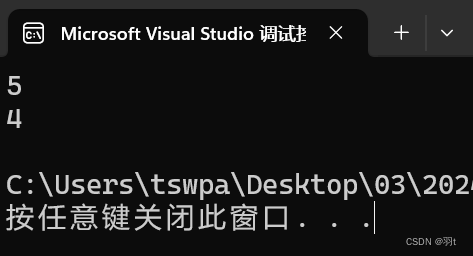
小堆:
#pragma once
#include<vector>
using namespace std;
namespace yut
{
template<class T>
struct less
{
bool operator()(const T& left, const T& right)
{
return left < right;
}
};
template<class T>
struct greater
{
bool operator()(const T& left, const T& right)
{
return left > right;
}
};
template<class T, class Container = vector<T>, class Compare = less<T>>
class priority_queue
{
public:
priority_queue()
{ }
/*
编不过,还没想明白
template<class Interator>
priority_queue(interator first, interator last)
{
_con(first, last);
for (int i = size() - 1; i >= 0; i--)
{
AdjustUp(i);
}
}
*/
void AdjustUp(int root)
{
int child = root;
int parents = (child - 1) / 2;
while (child > 0)
{
if (_con[child] < _con[parents])
{
::swap(_con[child], _con[parents]);
child = parents;
parents = (child - 1) / 2;
}
else
{
break;
}
}
}
void AdjustDown(int root)
{
int parents = root;
int child = parents * 2 + 1;
while (child < size())
{
if (child + 1 < size() && _con[child + 1] < _con[child])
{
child++;
}
if (_con[child] < _con[parents])
{
::swap(_con[child], _con[parents]);
parents = child;
child = parents * 2 + 1;
}
else
{
break;
}
}
}
bool empty()
{
return _con.empty();
}
size_t size()
{
return _con.size();
}
T& top()
{
return _con[0];
}
void push(const T& val)
{
_con.push_back(val);
for(int i=size()-1;i>=0;i--)
{
AdjustUp(i);
}
}
void pop()
{
::swap(_con[0], _con[size() - 1]);
_con.resize(size() - 1);
for (int i = 0; i < size() - 1; i++)
{
AdjustDown(i);
}
}
private:
Container _con;
};
}测试代码一样,代码运行结果如下: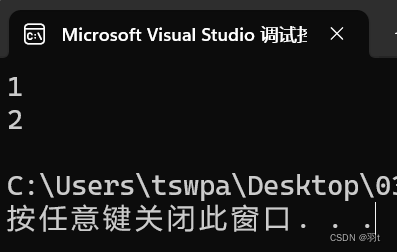
可以发现只有这几处变了:


故编写如下代码,使用仿函数(以后解释):
#pragma once
#include<vector>
using namespace std;
namespace yut
{
template<class T>
struct less
{
bool operator()(const T& left, const T& right)
{
return left < right;
}
};
template<class T>
struct greater
{
bool operator()(const T& left, const T& right)
{
return left > right;
}
};
template<class T, class Container = vector<T>, class Compare = less<T>>
class priority_queue
{
public:
priority_queue()
{ }
/*
编不过,还没想明白
template<class Interator>
priority_queue(interator first, interator last)
{
_con(first, last);
for (int i = size() - 1; i >= 0; i--)
{
AdjustUp(i);
}
}
*/
void AdjustUp(int root)
{
Compare com;
int child = root;
int parents = (child - 1) / 2;
while (child > 0)
{
if (com(_con[child], _con[parents]))
{
::swap(_con[child], _con[parents]);
child = parents;
parents = (child - 1) / 2;
}
else
{
break;
}
}
}
void AdjustDown(int root)
{
Compare com;
int parents = root;
int child = parents * 2 + 1;
while (child < size())
{
if (child + 1 < size() && com(_con[child + 1], _con[child]))
{
child++;
}
if (com(_con[child], _con[parents]))
{
::swap(_con[child], _con[parents]);
parents = child;
child = parents * 2 + 1;
}
else
{
break;
}
}
}
bool empty()const
{
return _con.empty();
}
size_t size()const
{
return _con.size();
}
T& top()
{
return _con[0];
}
void push(const T& val)
{
_con.push_back(val);
AdjustUp(size() - 1);
}
void pop()
{
if (empty())
return;
::swap(_con[0], _con[size() - 1]);
_con.pop_back();
AdjustDown(0);
}
private:
Container _con;
};
}测试代码:
#include"priority_queue.h"
#include<iostream>
using namespace std;
int main()
{
yut::priority_queue<int, vector<int>,greater<int>> q;
q.push(1);
q.push(2);
q.push(3);
q.push(4);
q.push(5);
cout << q.top() << endl;
q.pop();
cout << q.top() << endl;
return 0;
}代码运行结果如下: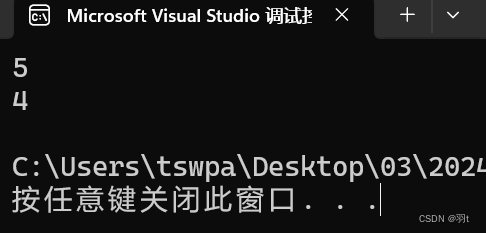
大家会发现大堆大于,这是因为我刻意改动的结果,使之更符合认知习惯。
4. 容器适配器
4.1 什么是适配器
适配器是一种设计模式(设计模式是一套被反复使用的、多数人知晓的、经过分类编目的、代码设计经验的总结),该种模式是将一个类的接口转换成客户希望的另外一个接口。
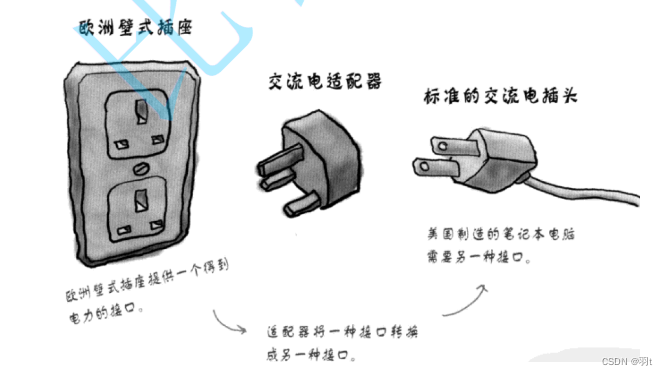
4.2 STL标准库中 stack 和 queue 的底层结构
虽然 stack 和 queue 中也可以存放元素,但在 STL 中并没有将其划分在容器的行列,而是将其称为容器适配器,这是因为 stack 和队列只是对其他容器的接口进行了包装,STL 中 stack 和 queue默认使用 deque,比如:



4.3 deque 的简单介绍(了解)
4.3.1 deque 的原理介绍
deque (双端队列):是一种双开口的"连续"空间的数据结构,双开口的含义是:可以在头尾两端进行插入和删除操作,且时间复杂度为O(1),与 vector 比较,头插效率高,不需要搬移元素;与 list比较,空间利用率比较高。

deque 并不是真正连续的空间,而是由一段段连续的小空间拼接而成的,实际 deque 类似于一个动态的二维数组,其底层结构如下图所示:
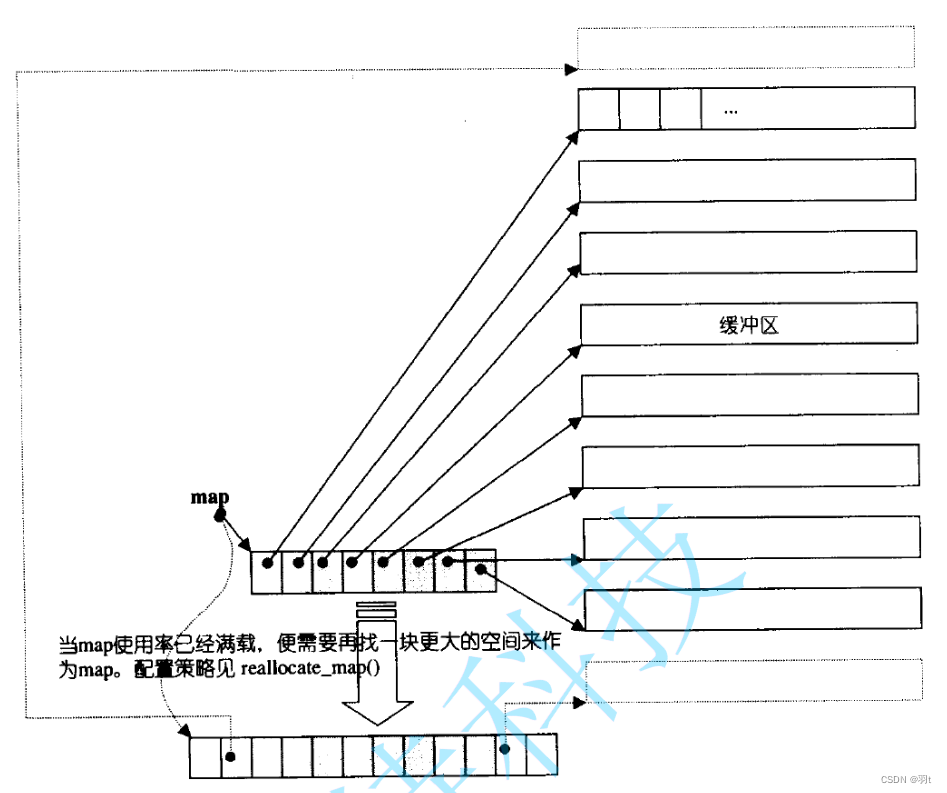
双端队列底层是一段假象的连续空间,实际是分段连续的,为了维护其”整体连续”以及随机访问的假象,落在了 deque 的迭代器身上,因此 deque 的迭代器设计就比较复杂,如下图所示:
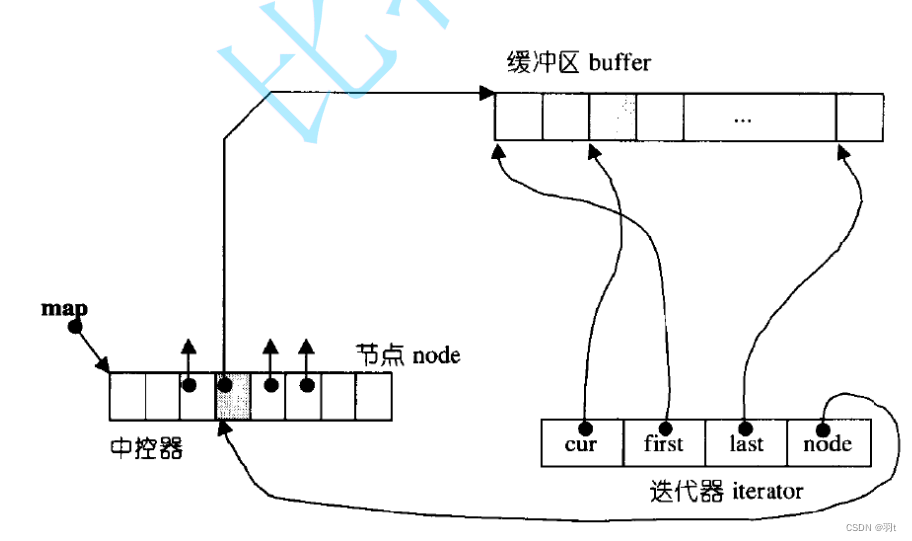
那 deque 是如何借助其迭代器维护其假想连续的结构呢?
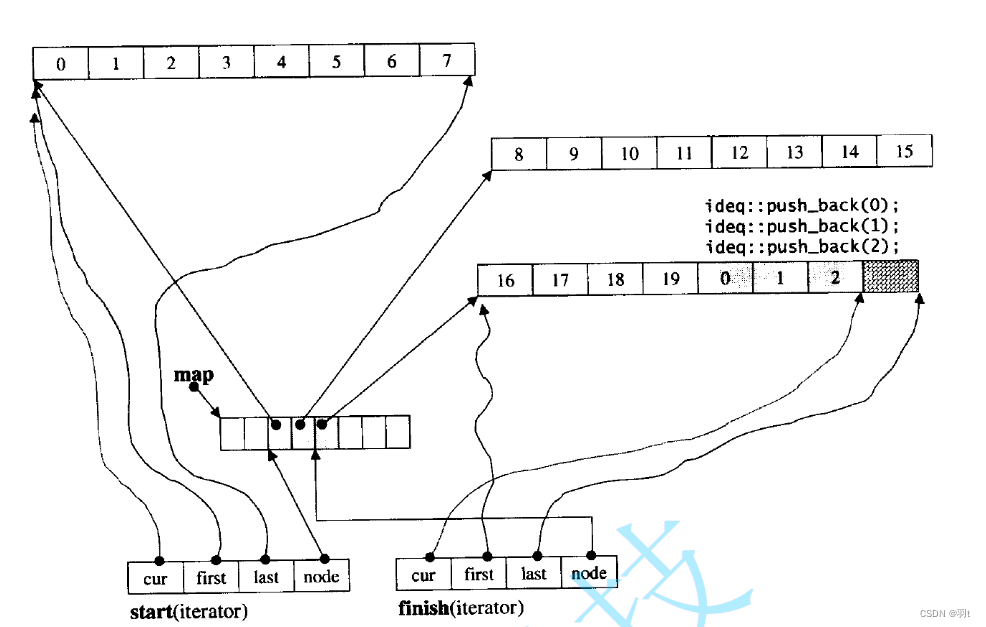
4.3.2 deque 的缺陷
与 vector 比较,deque 的优势是:头部插入和删除时,不需要搬移元素,效率特别高,而且在扩容时,也不需要搬移大量的元素,因此其效率是必 vector 高的。
与 list 比较,其底层是连续空间,空间利用率比较高,不需要存储额外字段。
但是,deque 有一个致命缺陷:不适合遍历,因为在遍历时,deque 的迭代器要频繁的去检测其是否移动到某段小空间的边界,导致效率低下,而序列式场景中,可能需要经常遍历,因此在实际中,需要线性结构时,大多数情况下优先考虑 vector 和 list,deque 的应用并不多,而目前能看到的一个应用就是,STL用其作为 stack 和 queue 的底层数据结构。
4.4 为什么选择 deque 作为 stack 和 queue 的底层默认容器
stack 是一种后进先出的特殊线性数据结构,因此只要具有 push_back() 和 pop_back() 操作的线性结构,都可以作为 stack 的底层容器,比如 vector 和 list 都可以;queue 是先进先出的特殊线性数据结构,只要具有 push_back 和 pop_front 操作的线性结构,都可以作为 queue 的底层容器,比如 list。但是 STL 中对 stack 和 queue 默认选择 deque 作为其底层容器,主要是因为:
1. stack 和 queue 不需要遍历 ( 因此 stack 和 queue 没有迭代器 ),只需要在固定的一端或者两端进行操作。
2. 在 stack 中元素增长时,deque 比 vector 的效率高(扩容时不需要搬移大量数据);queue 中的元素增长时,deque 不仅效率高,而且内存使用率高。
结合了deque的优点,而完美的避开了其缺陷。
简单试用:
#include<deque>
#include<iostream>
using namespace std;
int main()
{
deque<int> d;
d.push_back(1);
d.push_back(2);
d.push_back(3);
d.push_back(4);
for (auto& e : d)
{
cout << e << ' ';
}
return 0;
}
4.5 STL 标准库中对于 stack 和 queue 的模拟实现
4.5.1 stack 的模拟实现
#pragma once
#include<deque>
using namespace std;
namespace yut
{
template<class T,class Container=deque<T>>
class stack
{
public:
stack()
{ }
bool empty()
{
return _con.empty();
}
size_t size()
{
return _con.size();
}
T& top()
{
return _con[size() - 1];
}
void push(const T& val)
{
_con.push_back(val);
}
void pop()
{
_con.pop_back();
}
private:
Container _con;
};
}4.5.2 queue 的模拟实现
#pragma once
#include<deque>
using namespace std;
namespace yut
{
template<class T,class Container=deque<T>>
class queue
{
public:
queue()
{ }
bool empty()
{
return _con.empty();
}
size_t size()
{
return _con.size();
}
T& front()
{
return _con[0];
}
T& back()
{
return _con[size() - 1];
}
void push(const T& val)
{
_con.push_back(val);
}
void pop()
{
_con.pop_front();
}
private:
Container _con;
};
}





















 3085
3085











 被折叠的 条评论
为什么被折叠?
被折叠的 条评论
为什么被折叠?








